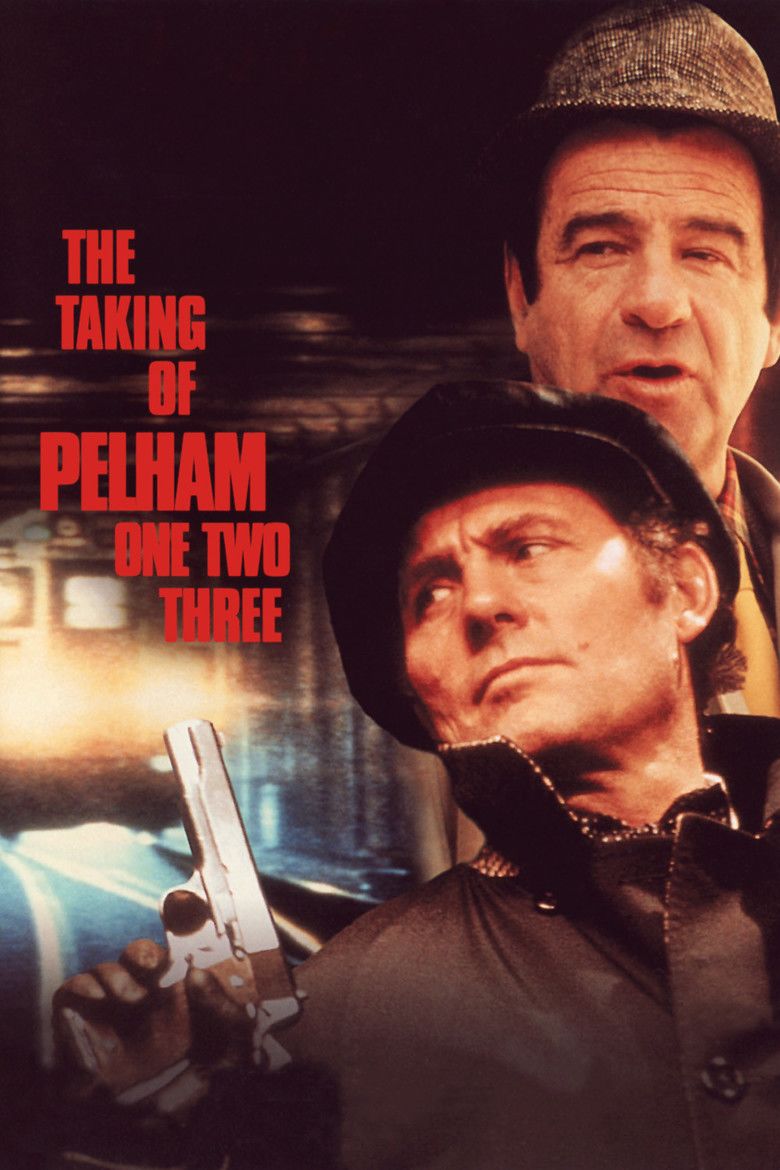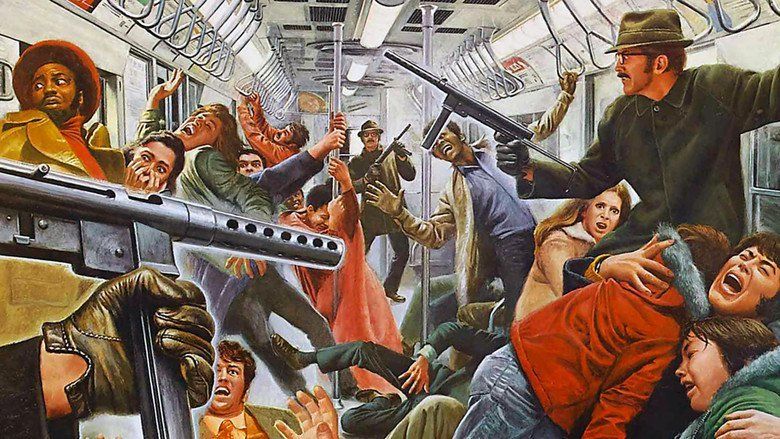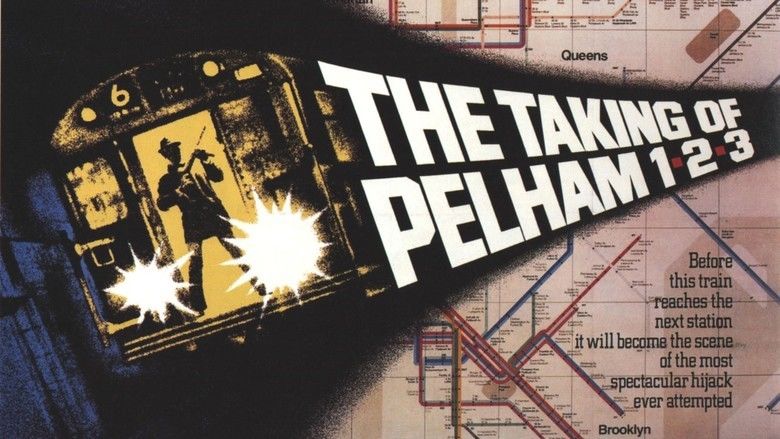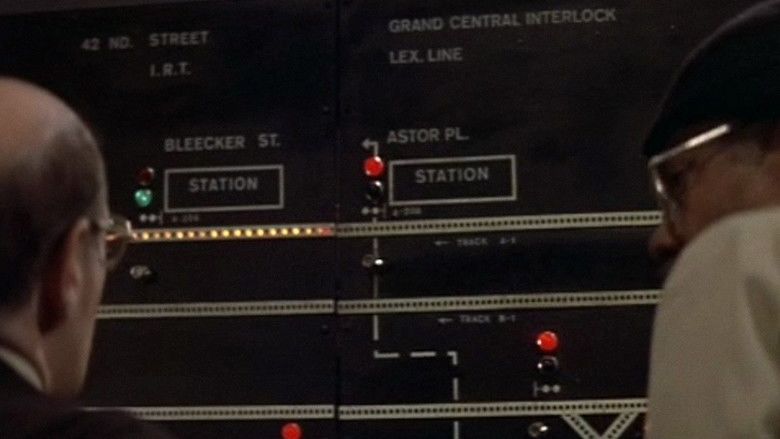The Taking of Pelham One Two Three (1974 film)
8.4 /10 1 Votes8.4
100% Rotten Tomatoes Initial DVD release February 29, 2000 Duration Language English | 7.7/10 IMDb 3/4 Roger Ebert Genre Action, Crime, Thriller Country United States | |||||||||||||||||||||||||||||||||
 | ||||||||||||||||||||||||||||||||||
Release date October 2, 1974 Based on The Taking of Pelham One Two Three by John Godey Cast (Lt. Zachary Garber), Robert Shaw (Mr. Blue - Bernard Ryder), (Mr. Green - Harold Longman), (Mr. Gray - Joe Welcome), (Mr. Brown - George Steever), (Denny Doyle - Train Conductor)Similar movies Mad Max: Fury Road , Salt , Blackhat , A Walk Among the Tombstones , Goodfellas , Die Hard Tagline We are going to kill one passenger a minute until New York City pays us 1 million dollars. | ||||||||||||||||||||||||||||||||||
The taking of pelham one two three official trailer 1 walter matthau movie 1974 hd
The Taking of Pelham One Two Three (a.k.a. The Taking of Pelham 1 2 3) is a 1974 American thriller film directed by Joseph Sargent, produced by Edgar J. Scherick, and starring Walter Matthau, Robert Shaw, Martin Balsam and Héctor Elizondo. Peter Stone adapted the screenplay from the 1973 novel of the same name written by Morton Freedgood under the pen name John Godey.
Contents
- The taking of pelham one two three official trailer 1 walter matthau movie 1974 hd
- The taking of pelham one two three original vs remake review
- Plot
- Filming locations
- Music
- Release
- Critical reception
- Accolades
- Remakes
- References

The movie received critical acclaim, and holds a rating of 100% on Rotten Tomatoes, based on 35 reviews. Several critics called it one of 1974's finest films, while also being a box office success. As in the novel, the film centers on a group of criminals taking the passengers hostage inside a New York City Subway car for ransom. Musically, it features "one of the best and most inventive thriller scores of the 1970s". It was remade in 1998 as a television film and was again remade in 2009 as a theatrical film. The Beastie Boys' song Sure Shot refers to "the taking of Pelham, one, two, three".

The taking of pelham one two three original vs remake review
Plot

On the New York City Subway, four men armed with submachine guns, wearing similar disguises, and using code names (Mr. Blue, Mr. Green, Mr. Grey, and Mr. Brown) board a downtown (southbound) 6 train at different station stops. The men take 17 passengers (one an undercover police officer) and the conductor hostage in the train's first car, and leave the rest of the train behind.

Meanwhile, Zachary Garber, a curmudgeonly Transit Authority police lieutenant, is leading a tour of the subway command center when it is interrupted by Blue's radio announcement that "your train has been taken". Blue, the leader of the hijackers, reveals their demand for $1,000,000, to be delivered within one hour, or they will kill one passenger per minute after that.

Garber, lieutenant Rico Patrone, and other transit workers cooperate while trying to guess how the criminals intend to get away. Garber deduces that the hijacker who knows how to operate the train is probably a disgruntled transit worker, and notices that Blue has a British accent, while Green has a severe cold which causes him to sneeze loudly several times throughout the ordeal whereby Garber responds each time with a polite "gesundheit".
The supervisor at Grand Central goes to confront the hijackers himself; Grey shoots him dead. Conversations between the hijackers reveal that Blue was a mercenary in Africa and Green was a motorman caught in a drug bust. There is tension between Blue and Grey; Blue confides to Green that he believes Grey is "mad" and potentially trouble.
The Mayor agrees to pay the ransom, but Blue still insists on his one-hour deadline. During the tense wait for the money, a police officer exchanges gunfire with the hijackers. In retaliation, Blue kills the conductor. Finally the money is ready. The police dispatch a squad car, but it crashes. Garber bluffs to buy time, telling the hijackers that the money has already been delivered to the tunnel and just has to be walked to the train. Blue accepts this. Minutes later, a police motorcycle does arrive with the ransom and it is delivered on down the tunnel on foot.
With money in hand, Blue gives Garber their next demands: that electric power be restored to the subway line, that all signals in the path of the train be set to green all the way to South Ferry, and all police officers be cleared from the tunnel. Garber says it will take time to move all other trains out of the way, which Blue accepts. Before the process is completed, the hijackers move the train forward a few blocks. Blue says this is in case there are still police in the tunnel.
When Garber says the signals are clear, the hijackers use a device to override the dead-man's switch so that the train can continue to operate with no one on board; then they set the train in motion and get off. As the one-car train starts to move, the undercover officer jumps off and hides. With no one controlling it, the car begins to travel faster and faster.
In the tunnel, the hijackers begin their escape via an emergency exit; however, Grey refuses to leave his gun behind, resulting in a stand-off with Blue, who shoots him dead. The undercover officer manages to kill Brown. Green escapes onto the street, while Blue shoots at the officer until he wounds him.
Garber follows the runaway train above ground until he realizes that the hijackers must have defeated the dead-man's switch, and returns to where the train stopped. He draws a gun on Blue, ordering him to surrender. Told that New York has no death penalty, Blue electrocutes himself by stepping onto the third rail. Meanwhile, as the runaway car enters the loop at South Ferry Station leading back uptown; the train's excessive speed activates the automatic safeties built into the system to stop cars travelling too fast; and the car grinds to a halt leaving the remaining hostages unharmed.
The three dead hijackers are identified; none was ever a transit employee. Garber concludes that the remaining hijacker must be the one. Working their way through a list of former motormen "discharged for cause", Garber and Patrone pay a visit to Harold Longman, knocking on his door just as he is reveling in his share of the ransom money. After hastily hiding the money, Longman lets them in and then successfully bluffs his way through their questioning. As they are leaving, however, he momentarily delays their departure by complaining indignantly about being suspected. With he and Patrone standing in the hall, Garber apologizes and then finally turns and begins to close the front door behind them. Just then, Longman sneezes, eliciting another polite "gesundheit" from Garber as the door closes. A moment later, Garber re-opens the door giving Longman an accusatory stare.
Filming locations
Portions of the scenes in the tunnel were filmed on the local tracks of the IND Fulton Street Line at the abandoned Court Street station in Brooklyn, now the New York Transit Museum. A reconstruction of a Transit Authority control center was built on a soundstage.
The exterior NYC 'Command Post Center' street scenes shot above the subway train during the cash negotiation scenes, where throngs of police and spectators gathered awaiting the ransom money, were filmed at the subway exit corner of 28th and Park Avenue South in Manhattan. The Metropolitan Transportation Authority was reluctant to cooperate with the making of this movie as they feared a real hijacking could occur, but after further talks, they cooperated with the filmmakers. First, they required payment of hijack insurance as well as a payment of $250,000 for usage of the subway. Another person who was involved was Mayor John Lindsay: he green lighted the shooting of the film in New York, though some Canadian passages were done as well.
Music
The Jerry Fielding and Don Ellis sounding score, composed and conducted by David Shire, "layers explosive horn arrangements and serpentine keyboard riffs over a rhythm section that pits hard-grooving basslines against constantly shifting but always insistent layers of percussion". Shire used the 12-tone composition method to create unusual, somewhat dissonant melodic elements. The soundtrack album was the first CD release by Film Score Monthly, and was later released by Retrograde Records. The end titles contain a more expansive arrangement of the theme, courtesy of Shire's wife at the time, Talia Shire, who suggested that he end the score with a more traditional ode to New York.
Release
The Taking of Pelham One Two Three was released on October 2, 1974. It grossed $16,550,000 at the box office and was filmed with a $5,000,000 budget. Realizing that it would become too much of a reminder to the public after this movie was released, the New York City Transit Authority for many years banned any train leaving Pelham station at 1:23. Eventually this policy was rescinded but the dispatchers have generally avoided scheduling a Pelham train at 1:23.
Critical reception
The film was well received by critics. Roger Ebert's contemporary review gave the film 3 out of a possible 4 stars. He praised the film's "unforced realism", and the supporting characters who elevated what could have been a predictable crime thriller: "we care about the people not the plot mechanics. And what could have been formula trash turns out to be fairly classy trash, after all."
Accolades
Remakes
In 1998, the film was remade as a television film with the same title, with Edward James Olmos in the Matthau role and Vincent D'Onofrio replacing Shaw as the senior hijacker. Although not particularly well received by critics or viewers, this version was reportedly more faithful to the book, though it revised the setting with new technologies.
Another remake set in a post 9/11 New York City directed by Tony Scott and starring Denzel Washington and John Travolta, was released in 2009 to mixed reviews.
References
The Taking of Pelham One Two Three (1974 film) WikipediaThe Taking of Pelham One Two Three (1974 film) IMDbThe Taking of Pelham One Two Three (1974 film) Rotten TomatoesThe Taking of Pelham One Two Three (1974 film) Roger EbertThe Taking of Pelham One Two Three (1974 film) themoviedb.org
